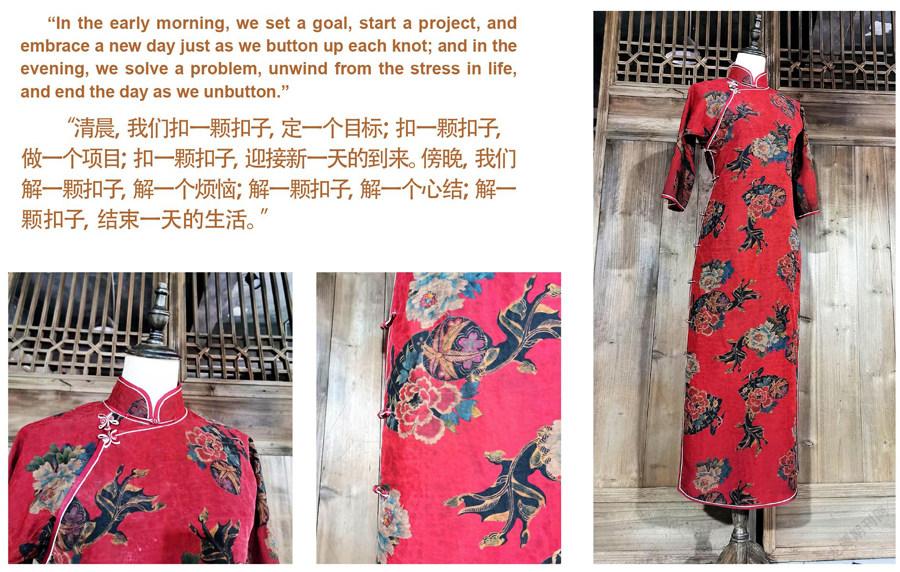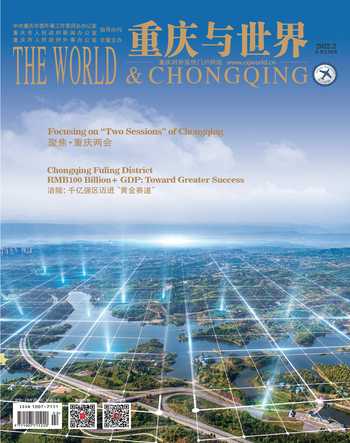外事好礼·百年君临旗袍
刘丁睿




A silky cheongsam narrates the beauty of passing years, and a satin gown tells the story of alluring elegance.
In January 2022, Jiang Lingjun, the third-generation successor of a century-old brand—Chongqing Junlin Cheongsam (Qipao), was invited to present the Chongqing-style cheongsam at the maiden voyage of the “Yangtze River III” cruise ship, where a “flowing cheongsam museum on the Yangtze River” was elaborately set up aboard. Cheongsams and high heels were exhibited together with long gowns and suits, offering an exquisite cheongsam feast for hundreds of tourists from home and abroad.
Jiang Lingjun was wearing cheongsams handmade by herself throughout the 8-day voyage, whether she was on the cruise, at scenic spots, or even skiing. “Cheongsam fits all seasons. We can wear cheongsam made with different materials or thicknesses on different occasions. In the 1930s and 1940s, it was daily clothing. Especially in Chongqing, it was quite common.” said Jiang Lingjun in an interview with The World and Chongqing on January 27th, the day she returned to Chongqing, “I wear cheongsam to be the spokesperson of Junlin Cheongsam.”
Junlin Cheongsam as Gifts for Foreign Affairs Events
Located at an old street in the Shapingba District of Chongqing, the entrance of Junlin Cheongsam Museum was rather discreet. Upon entering the third floor, a closed bamboo door surfaced and one needs to ring a hanging bell. A girl in cheongsam answered the door. Welcomed by beating drums and gongs, the stairs took guests upstairs. The moment guests entered the museum, walls full of written words came into view, in Chinese, English, French, Spanish, Korean, and more:
“my home in china”
“j’amie ça ici, je reviens” (French - I love everything here. I’ll be back.)
“in china, casa mea” (Romanian - My home in China.)……
Jiang Lingjun told us that these words were left by visitors. This museum also acts as Jiang’s cheongsam workshop and a cheongsam-themed homestay. It has received hundreds of tourists from 138 countries, who are fascinated with traditional Chinese costumes and fond of cheongsam.
In the museum, you can also appreciate the beauty of retro cheongsam, modified cheongsam, Chinese-style men’s wear, children’s cheongsam, and Chinese-style women’s wear. They are made of gambiered Guangdong gauze, mulberry silk, satin, Song brocade, cotton, hemp, and other materials. These Chinese-style clothing are displayed together with ancient beds, old-fashioned square tables, floor screens, and draperies, taking the visitors on a journey back to a century ago.
A delicate craft ornament, about 35 centimeters tall and 25 centimeters wide, in a blue floral cheongsam with Chinese button knots was quite eye-catching. As Jiang Lingjun introduced, to better inherit and display the Chinese cheongsam culture, the workshop designed and made a series of unique and portable cheongsam-themed craft ornaments and souvenirs. This “Junlin Cheongsam Craft Ornament” was one of them and it was selected as a “Chongqing Gift for Foreign Affairs Events” in 2021.
A Century-old Shop of Intangible Cultural Heritage
Traditional Chinese knot buttons include designs such as straight knots, butterfly-shaped knots, calabash-shaped knots, and Pipa-shaped buttons. They bear not only auspicious meanings but also serve as the finishing highlights of a cheongsam. Jiang Lingjun put on her glasses and told her story while doing needlework.
Junlin Cheongsam has gone through four generations, from her grandparents’ door-to-door sewing and her mother’s small tailor shop to her transition from factory uniforms to handmade cheongsams with her assistant Zhang’s independent customization.
High collars, diagonal lapels, slits, bias strips, beads, frog closures, embroidery… Making a cheongsam by hand requires over a hundred processes, including material selection, tailoring, cutting, and more. Among them, cheongsams of vintage designs are all handmade or semi-handmade as required by customers. Jiang Lingjun said that customizing a cheongsam takes at least 15 days, some even take a year or two because some embroidery needs to be done by specific professionals.
As she spoke, Jiang Lingjun knocked loudly on the wooden desk, and a woman walking by stopped and looked back. It was learned from the gestures and lip-reading that all the frog closures of handmade cheongsams were made by this female worker with hearing loss. Apart from the process of embroidery, there are other craft souvenirs relating to cheongsams, including handmade cloth animals, sachets with lucky Chinese characters, cell phone bags, silk cotton masks, etc. As Jiang Lingjun said, every day she thinks about how to let more people know about cheongsam culture and how to make more creative products based on traditional craftsmanship, so that more people will fall in love with cheongsam and she can also help more people with disabilities to find a job or even start a business.
Chongqing-style Cheongsam with Cultural Confidence
“One single piece of garment with sleeves connected to the main body, coupled with a stand collar with buttons and side slits… The tailoring of cheongsams implies the Chinese philosophy of ‘Heaven and Earth’.” Jiang Lingjun said that customizing a cheongsam is not just to make a piece of clothing, but to polish a work of art.
The 1930s was the golden time for the development of cheongsam. As the National Government of the Republic of China relocated westward to Chongqing, various cultures merged in the mountain city, and cheongsam also changed with the times. The Chongqing-style cheongsam represents the generous and inclusive Beijing-style cheongsam as well as the fashionable and international Shanghai-style cheongsam. It is both loose and well-fitting, sexy but not tight, making it a unique feature of the mountain city. At that time, both young ladies and college students wore cheongsams, which even influenced foreigners in China. Jiang Lingjun rolled the handle of an old phonograph in her studio, and the sound of squeaky music sang. “It was given to my grandmother by a Japanese customer at the time because his wife liked her cheongsam made by my grandmother very much.”
“Today, cheongsam is a ‘luxury’ among our national costumes in China. Now not only Chinese people, but more and more foreigners, even foreign influencers are coming to us to customize cheongsams.” Jiang Lingjun is quite proud.
“China has great etiquette, thus called Xia; it enjoys the beauty of clothing, thus called Hua. (Huaxia, another name of China)” This famous quote from the Legend of Spring and Autumn Century by Zuo Qiuming expresses the important meaning of clothing in the history of China. As a cultural carrier and medium, cheongsam carries human wisdom such as history, art, aesthetics, customs, etc., representing Chinese national culture and its language.
“Wearing cheongsam is to exhibit our confidence in culture.”
To promote the cheongsam culture, Jiang Lingjun often brings her team and various styles of cheongsams to participate in cultural activities and entrepreneurship contests at home and abroad, exhibiting and giving speeches on traditional art while learning ideas of innovation. They have attended the Western China International Fair for Investment and Trade, Western China Tourism Industry Expo and Chongqing International Cultural & Tourism Industry Expo held in Chongqing and participated in cultural and tourism expos, international cultural expos, international fairs for investment and trade, and Silk Road international expos in Hainan, Wuhan, Xining, Hefei, Changsha, and other places. They have also held academic salon activities of “Inheritors Talk About Inheritance” in communities, companies, and schools to share the knowledge and craftsmanship of cheongsam.
Some Photos/The interviewee
一袭青衣,染就一树芳华。两袖月光,诉说绝世风雅。
2022年1月,重庆百年君临旗袍第三代传人蒋玲均受邀携渝派旗袍亮相“长江叁号”游轮首航,在轮船上精心打造了一所“长江上流动的旗袍博物馆”。旗袍与高跟鞋、长衫和西服相互碰撞交织,为百名国内外游客带来一场场精美绝伦的旗袍盛宴。
无一例外,在8天的航程中,蒋玲均在游轮上、在景区,甚至体验滑雪,她都身着自己制作的手工旗袍。“穿着旗袍不分四季。可以不同场合穿着面料不同厚薄不同的旗袍。它在(20世纪)三四十年代就是大众的普通穿着。尤其在重庆。”1月27日,蒋玲均刚刚回到重庆就接受了本刊记者的采访,“我身着旗袍就是为君临旗袍代言。”
君临旗袍·外事好礼
通过隐匿在沙坪坝老街的入口走上三楼,记者来到一扇关闭的竹门前,拉响垂着的铃铛,一位身着旗袍的姑娘前来开门。敲锣、击鼓,拾级而上进入君临旗袍博物馆,映入眼帘的是写满中文、英文、法文、西班牙语、韩语等不同语言的几面留言墙:
“my home in china”(我在中国的家)
“j’amie ça ici,je reviens”(我喜欢这里的一切,我會再回来)
“in china,casa mea” (我在中国的家)……
蒋玲均说,这些是游客参观体验后留下的。博物馆同时是蒋玲均的旗袍工作室,也是旗袍主题民宿,这里已来过138个国家的数百名游客,他们对中国传统服饰充满好奇,十分欣赏和喜爱旗袍。
博物馆内,香云纱、桑蚕丝、绸缎、宋锦、棉、麻等各种材质的复古旗袍、改良旗袍、中式男装、童装旗袍、中式女装琳琅满目,这些中式服装与古床、八仙桌、屏风、帷幔陈设在一起,让人仿佛穿越到百年前。
一件高度约35厘米、宽度约25厘米,身着一字扣、蓝色碎花旗袍的精致工艺摆件吸引了记者的目光。蒋玲均介绍,为了更好地传承和展示中国旗袍文化,工作室设计制作了一系列独具特色、便于携带的旗袍工艺摆件及周边。其中这件“君临旗袍工艺摆件”入选2021“重庆好礼·外事礼品”。
百年老店·非遗技艺
一字扣、蝴蝶扣、葫芦扣、琵琶扣,不仅有着各种吉祥的寓意,更是一件旗袍的点睛之处。蒋玲均戴上眼镜,一边做着针线一边向记者娓娓道来。
从外公外婆上门缝制,到母亲小店裁缝,到蒋玲均从工厂制服转向手工旗袍,再到助理小张独立完成定制,君临旗袍经历了四代人的传承。
高领、斜襟、开叉,滚边、钉珠、盘扣、刺绣……从选料、量身、裁剪到手工,做一件旗袍整个工序多达上百道。其中,复古旗袍会根据客人的要求,有全手工、半手工。蒋玲均说,定做一件旗袍最少需要15天,更长甚至一两年,因为有的绣花要专人来做。
说话间,蒋玲均用手重重地敲了一下木桌,一位从旁走过的女子一顿,回过头来。一番比划加唇语,记者才知道,这些手工旗袍的各式盘扣都是这位聋人女工做的。包括绣花这道工艺,还有手作布艺动物、福字香包、手机布袋、丝棉口罩等旗袍周边工艺品,就是蒋玲均说的,她每天都在思考怎样让更多人了解旗袍文化、如何在传统工艺上创新产品,这样不仅可以让更多人喜爱旗袍,同时可以帮助更多残障人士就业、创业。
渝派旗袍·文化自信
“单片衣料、衣身连袖,立领盘纽、摆侧开叉……旗袍的裁制暗含‘天圆地方’的中国哲学思想。”蒋玲均说,定制旗袍不仅仅是做成一件衣服,对于我们来说更是在打磨一件艺术品。
20世纪30年代是旗袍发展的鼎盛时期,随着国民政府西迁至重庆,各种文化在山城融合,旗袍也因势而变。既有京派旗袍的大气也有海派旗袍的洋气,既宽松又合身,既性感又不紧身的渝派旗袍也因此具有了山城的特质。当时无论是大家闺秀还是院校学生都穿旗袍,甚至影响了在华的外国人。蒋玲均摇动着工作室内一台“古老”的留声机的手柄,吱吱呀呀的音乐声响起。“这是当时一位日本客人送给我外婆的,因为他夫人非常喜欢外婆做的旗袍。”
“而今,旗袍就是我们民族服饰中的‘奢侈品’。现在不仅仅是国人,越来越多的外国人,甚至外国网红都来我们这里定制旗袍。”蒋玲均为此很骄傲。
“中国有礼仪之大,故称夏;有服章之美,谓之华。”这句出自《春秋左转正义》的名句道出了服饰在华夏历史中重之要意。而旗袍作为一种文化载体和传播媒介,承载了历史、艺术、美学、风俗等人类智慧,代表着民族的文化,代表着自己的语言。
“旗袍穿上身,文化有自信。”
为了传播旗袍文化,蒋玲均经常带着团队和各式旗袍参加国内外的文化活动和优秀创业大赛,对传统艺术进行展览和演说,同时吸取创新经验。他们出现在重庆举行的西洽会、西旅会、文博会,也参加了海南、武汉、西宁、合肥、长沙等地的文化旅游博览会、国际文化博览会、国际贸易洽谈会、丝绸之路国际博览会等;还在社区、企业、学校开展“传承人讲传承”“一块布的DIY”等活动,分享旗袍的相关知识及制作工艺。
部分图片/受访人提供

